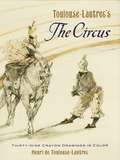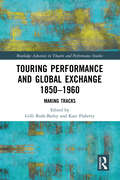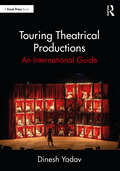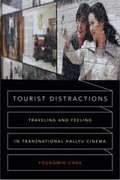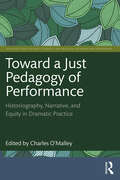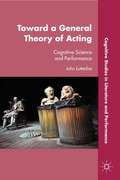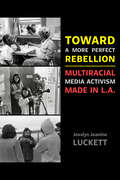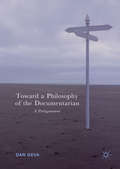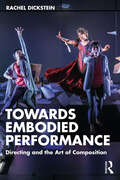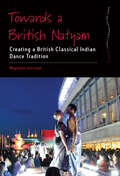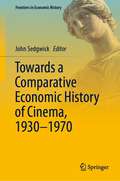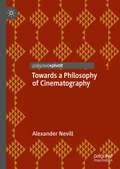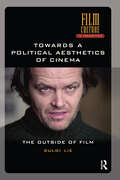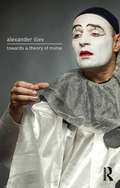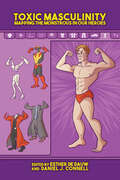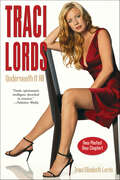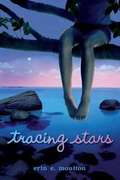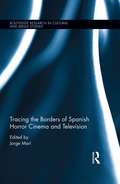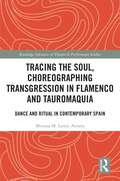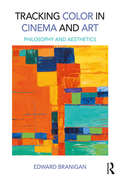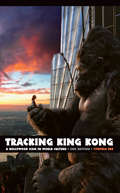- Table View
- List View
Toulouse-Lautrec's The Circus: Thirty-Nine Crayon Drawings in Color (Dover Fine Art, History Of Art Series)
by Henri de Toulouse-LautrecA bareback rider's skirt ripples in the breeze, an acrobat bends his muscular limbs into a handstand, and a poodle obeys a clown brandishing a whip. The circus is in town! These kaleidoscopic visions from under the big top offer audiences a series of post-Impressionistic sideshows, courtesy of thirty-nine brilliant crayon drawings in the distinctive style of Toulouse-Lautrec.These scenes took place far from the artist's customary haunts, the bars and cafes of Montmartre. While Toulouse-Lautrec was at the height of his artistic powers, he was compelled to undergo treatment for alcoholism at a country clinic. Seeking relief from his forced confinement, he sketched vignettes from a local circus troupe's rehearsals. His sensitive interpretations of the scenes reflect the cruelty behind the performers' exotic feats, as well as his self-image as an entertainer, an outsider, and a captive.Although these drawings are masterpieces of composition and movement, the artist gave them away. The originals were scattered across Europe and America for decades, until an intrepid collector tracked them down. These reproductions are the work of a noted lithographer, Fernand Mourlot, whose skill recaptures the color and spirit of Toulouse-Lautrec's works.
Touring Performance and Global Exchange 1850-1960: Making Tracks (Routledge Advances in Theatre & Performance Studies)
by Gilli Bush-BaileyThis collection uncovers connections and coincidences that challenge the old stories of pioneering performers who crossed the Atlantic and Pacific oceans from the mid-nineteenth to the mid-twentieth century. This book investigates songlines, drama, opera, music theatre, dance, and circus—removing traditional boundaries that separate studies of performance, and celebrating difference and transformation in style, intention, and delivery. Well known, or not known at all, travelling performers faced dangers at sea and hazardous journeys across land. Their tracks, made in pursuit of fortune and fame, intersected with those made by earlier storytellers in search for food. Making Tracks takes a fresh look at such tracks—the material remains—demonstrating that moving performance does far more than transfer repertoires and people; it transforms them. Touring performance has too often been conceived in diasporic terms, as a fixed product radiating out from a cultural centre. This collection maps different patterns—ones that comprise reversed flows, cross currents, and continually proliferating centres of meaning in complex networks of global exchange. This collection will be of great interest to scholars and students in theatre, music, drama studies and cultural history.
Touring Theatrical Productions: An International Guide
by Dinesh YadavTouring Theatrical Productions: An International Guide is a practical and comprehensive overview of planning, staging and closing international touring productions. This book offers a step-by-step chronological journal of preparing a company for international touring, from applying for international visas to returning home after a tour. It includes discussions of invitations, contracts, scheduling, health and safety, personnel, packing and shipping, certifications, insurance, travel, unions, hotels, ethics and cuisines. Each chapter is filled with guidelines, samples of paperwork and checklists to ensure the smooth running of any international tour. Written by the Production Manager and Technical Director of India’s most travelled show The Manganiyar Seduction with Can & Abel Theatres, this book includes examples, incidents and experiences of performing in over 20 countries with over 200 shows. This how-to guide will benefit Technical Directors and Production Managers of touring productions, as well as students in Production Management, Tour Management, Art Administration and Technical Theater courses.
Touring Variety in the Asia Pacific Region, 1946–1975 (Transnational Theatre Histories)
by Jonathan BollenAviation extended the horizon of international touring across Asia and the Pacific in the 1950s and 1960s. Nightclubs in Hong Kong, Manila, Melbourne, Singapore, Sydney, Tokyo, and Taipei presented an international array of touring acts. This book investigates how this happened. It explores the post-war formation of the Asia Pacific region through international touring and the transformation of entertainment during the ‘jet age’ of aviation. Drawing on archival research across the region, Bollen investigates how touring variety forged new relations between artists, audiences, and nations. Mapping tours and tracing networks by connecting fragments, he reveals how versatile artists translated repertoire in circulation as they toured, and how entrepreneurial endeavours harnessed the production of national distinction to government agendas. He argues that touring variety on commercial circuits diversified the repertoire in regional circulation, anticipating the diversity emerging in state-sanctioned multiculturalisms, and driving the government-construction of national theatres for cultural diplomacy.
Tourist Distractions: Traveling and Feeling in Transnational Hallyu Cinema
by Youngmin ChoeIn Tourist Distractions Youngmin Choe uses hallyu (Korean-wave) cinema as a lens to examine the relationships among tourism and travel, economics, politics, and history in contemporary East Asia. Focusing on films born of transnational collaboration and its networks, Choe shows how the integration of the tourist imaginary into hallyu cinema points to the region's evolving transnational politics and the ways Korea negotiates its colonial and Cold War past with East Asia's neoliberal present. Hallyu cinema's popularity has inspired scores of international tourists to visit hallyu movie sets, filming sites, and theme parks. This tourism helps ease regional political differences; reimagine South Korea's relationships with North Korea, China, and Japan; and blur the lines between history, memory, affect, and consumerism. It also provides distractions from state-sponsored narratives and forges new emotional and economic bonds that foster community and cooperation throughout East Asia. By attending to the tourist imaginary at work in hallyu cinema, Choe helps us to better understand the complexities, anxieties, and tensions of East Asia's new affective economy as well as Korea's shifting culture industry, its relation to its past, and its role in a rapidly changing region.
Toward A Just Pedagogy Of Performance: Historiography, Narrative, And Equity In Dramatic Practice (Routledge Series in Equity, Diversity, and Inclusion in Theatre and Performance)
by Charles O’MalleyThis book is a compendium of resources largely by and for artists and scholars interested in engaging in conversations of justice, diversity, and historiography in the fields of theatre and performance studies. For these students, and for the future instructors in our field who will use this book, we hold a tripartite hope: to expand, to enable, and to provide access. In its whole, we intend for this book to provoke its readers to question the narratives of history that they’ve received (and that they may promulgate) in their artistic and scholarly work. We aim to question methods and ethics of reading present in the western mode of studying drama and performance history. The contributions in the book—not traditional chapters, but manifestos, experiences, articles, conversations, and provocations—raise questions and illuminate gaps, and they do not speak in a unified voice or from a static position. These pieces are written by artists, graduate students, teachers, administrators, and undergraduates; these are expressions of hope and of experience, and not of dogma. This book is aimed toward instructors of undergraduates, both graduate students and faculty at all levels of seniority within theatre and performance studies, as well as at artists and practitioners of the art that wish to find more just ways of viewing history.
Toward a General Theory of Acting
by John LutterbieToward a General Theory of Acting explores the actor's art through the lens of Dynamic Systems Theory and recent findings in the Cognitive Sciences. An analysis of different theories of acting in the West from Stanislavski to Lecoq is followed by an in depth discussion of technique, improvisation, and creating a score. In the final chapter, the focus shifts to how these three are interwoven when the actor steps in front of an audience, whether performing realist, non-realist, or postdramatic theatre. Far from using the sciences to reduce acting to a formula, Lutterbie celebrates the mystery of the creative process.
Toward a More Perfect Rebellion: Multiracial Media Activism Made in L.A.
by Josslyn Jeanine LuckettToward a More Perfect Rebellion tells the riveting story of the socially engaged filmmakers of color who studied in the Ethno-Communications Program at the University of California, Los Angeles, between 1969 and 1973. While the program is best known for training the trailblazing group of Black directors known as the L.A. Rebellion, this book also includes the radical Asian American, Chicana/o, and Native American filmmakers who collaborated alongside their Black classmates to create one of the most expansive and groundbreaking bodies of work of any US university cohort. Through extensive interviews with the filmmakers and cross-racial analysis of their collective filmography, Josslyn Jeanine Luckett sheds light on a largely untold history of media activists working outside Hollywood yet firmly rooted in Los Angeles, aiming their cameras with urgency and tenderness to capture their communities' stories of power, struggle, and improvisational brilliance.
Toward a Philosophy of the Documentarian: A Prolegomenon
by Dan GevaThe theme of this book is the documentarian—what the documentarian is and how we can understand it as a concept. Working from the premise that the documentarian is a special—extended—sign, the book develops a model of a quadruple sign structure for-and-of the documentarian, growing out of enduring traditions in philosophy, semiotics, psychoanalysis, and documentary theory. Dan Geva investigates the intellectual premise that allows the documentarian to show itself as an extremely sophisticated, creative, and purposeful being-in-the-world—one that is both embedded in its own history and able to manifest itself throughout its entire documentary life project, as a stand-alone conceptual phase in the history of ideas.
Toward an Anthropology of Screens: Showing and Hiding, Exposing and Protecting
by Mauro Carbone Graziano LinguaThis book shows that screens don’t just distribute the visible and the invisible, but have always mediated our body's relationships with the physical and anthropological-cultural environment. By combining a series of historical-genealogical reconstructions going back to prehistoric times with the analysis of present and near-future technologies, the authors show that screens have always incorporated not only the hiding/showing functions but also the protecting/exposing ones, as the Covid-19 pandemic retaught us. The intertwining of these functions allows the authors to criticize the mainstream ideas of images as inseparable from screens, of words as opposed to images, and of what they call “Transparency 2.0” ideology, which currently dominates our socio-political life. Moreover, they show how wearable technologies don’t approximate us to a presumed disappearance of screens but seem to draw a circular pathway back to using our bodies as screens. This raises new relational, ethical, and political questions, which this book helps to illuminate.
Towards Embodied Performance: Directing and the Art of Composition
by Rachel DicksteinTowards Embodied Performance invites directors and other generative performance makers to experiment with making their own original, visually stunning, sonically immersive, and physically rigorous embodied performance.Through historical context, the author’s 30-plus years of experience, and original interviews with leading theatre artists, this book sets the stage for a new generation of artists building boundary-breaking work. Directors are often categorized into one of only two frameworks: the Stanislavskian director, whose method is based on text analysis and character wants and needs, and the “auteur” director, whose work might focus on visual spectacle at the expense of text or character objectives. This book argues that the director of embodied performance fuses these two approaches, acting as the author of the event. In Part I, readers will explore the core elements of embodied performance – space, time, body, language, and action – through a lens that bridges traditional directing methodology with experimental, devised, collaborative theatre-making. Part II provides examples of this embodied practice by multi-disciplinary artists in visual and sound installation, video and film, dance-theatre, and new music/opera, including such artists as Shirin Neshat, James Turrell, Bill T. Jones, Janet Cardiff, Okwui Okpokwasili, William Kentridge, and Heather Christian. Part III suggests creative prompts and exercises for performance makers to engage the visual, physical, textual, and sonic in compositional storytelling on stage.Towards Embodied Performance is an invaluable resource for theatre directors, devisers, and generative artists at all levels from students to teachers, from early-career to mid-career artists. Directors, actors, choreographers, designers, composers, writers, scholars, and engaged audience members can all use this text to explore collaboratively created performance that invites its audience into the ripest version of the present moment.
Towards Queer Literacy in Elementary Education: Always Becoming Allies (Queer Studies and Education)
by Selena E. Van HornThis book blends multiple research studies, historical and current events, reflective teaching examples, and guidance for LGBTQ+ inclusion and queer pedagogy in elementary schools. It is divided into three sections to guide the readers from a broad understanding of the hxstories of LGBTQ+ discriminations, rights, and some communities’ resistance to LGBTQ+ children, teachers, and curriculum to a focused invitation into the author's own reflections, teaching, and discussions with children about LGBTQ+ literature and topics. The volume provides hxstories, theoretical and methodological inquiry, resources, and encouragement for teacher-researchers ready to engage LGBTQ+-inclusion and queer literacy pedagogy in their classrooms, schools, and communities.
Towards a British Natyam: Creating a British Classical Indian Dance Tradition (Dance and Performance Studies)
by Magdalen GorringeThe story of the emerging professionalization of classical Indian dance forms in Britain is wrought with contradictions. Though becoming increasingly popular within mainstream culture, the forms lack the clear routes to vocational training so essential for creating a dance career in the traditional sense. Towards a British Natyam uses this lens to analyze the cultural, social, and political frameworks that make a profession possible within the arts. Innovatively drawing on the work of decolonial theorists and the sociologist Pierre Bourdieu, Gorringe illuminates the transformative potential of a classical Indian dance profession to decenter white supremacist modes of knowledge formation and recenter pluriversality.
Towards a Comparative Economic History of Cinema, 1930–1970 (Frontiers in Economic History)
by John SedgwickThis book examines the economic circumstances in which films were produced, distributed, exhibited, and consumed during the spoken era of film production until 1970. The periodisation covers the years between the onset of sound and the demise of the phased distribution of films. Films are generally appreciated for their aesthetic qualities. But they are also commodities. This work of economic history presents a new approach, considering consumption behaviour as significant as supply-side decision-making. Audiences’ tastes are considered central, with box-office an indicator of what they liked. The POPSTAT Index of Film Popularity is used as a proxy where box office knowledge is missing. Comparative analysis is conducted through the tool RelPOP. The book comprises original case studies covering film consumption in Great Britain, the Netherlands, Sweden, and the United States during the 1930s; Australia and occupied Belgium during the Second World War; and Italy, the United States, Poland and Czechoslovakia during the Post-war. An overriding theme is how the classical American business model, which emerged during the 1910s linking production to distribution and exhibition, adapted to local circumstances, including the two countries behind the Iron Curtain during the years of ‘High Stalinism’.
Towards a Philosophy of Cinematography
by Alexander NevillThis book presents three interrelated essays about cinematography which offer a theoretical understanding of the ways that film practitioners orchestrate light in today’s post-digital context. Cinematography is a practice at the heart of film production which traditionally involves the control of light and camera technologies to creatively capture moving imagery. During recent years, the widespread adoption of digital processes in cinematography has received a good deal of critical attention from practitioners and scholars alike, however little specific consideration about evolving lighting practices can be found amongst this discourse. Drawing on new-materialist ideas, actor-network theory and the concept of co-creativity, these essays examine the impact of changing production processes for the role and responsibilities of a cinematographer with a specific focus on lighting. Each essay advances a new perspective on the discipline, moving from the notion of light as vision to light as material, from technology as a tool to technology as a network, and from cinematography as an industry to cinematography as a collaborative art.
Towards a Political Aesthetics of Cinema: The Outside of Film (Film Culture in Transition)
by Sulgi LieTowards a Political Aesthetics of Cinema: The Outside of Film is a contribution to an aesthetics of cinema rooted in Marxist theory. Rather than focusing on the role that certain films, or the cinema as an institution, might play in political consciousness, the book asks a different question: how can the subject of politics in film be thought? This problem is presented in a systematic-theoretical rather than historical manner. The main aim of this book is a retrospective rehabilitation of the psychoanalytical concept of suture, whose political core is progressively revealed. In a second step, this rereading of suture-theory is mediated with the Marxist aesthetics of Fredric Jameson. From the perspective of this reconfigured aesthetics of negativity, films by Hitchcock, Antonioni, Haneke and Kubrick are analyzed as articulations of a political unconscious.
Towards a Theory of Mime
by Alexander IlievTowards a Theory of Mime is a genuinely unique book about non-verbal communication and performance. Combining a broad global history of the evolution of human communication with an introduction to the general practice of mime, Alexander Iliev traces a lineage from Marceau and Barrault to his own distinguished practice as performer and teacher. The book moves from a fascinating description of the first principles of gestural language to a stunning sequence of specific exercises in practical training.Written in a sometimes poetic, always accessible and often humorous style, Towards a Theory of Mime conveys complex ideas in a strikingly accessible way.Alexander Iliev has over forty years experience practising and teaching both theatre and anthropology around the world. He is currently Associate Professor at the National Academy in Sofia.
Toxic Masculinity: Mapping the Monstrous in Our Heroes
by Esther De Dauw and Daniel J. ConnellContributions by Daniel J. Connell, Esther De Dauw, Craig Haslop, Drew Murphy, Richard Reynolds, Janne Salminen, Karen Sugrue, and James C. Taylor The superhero permeates popular culture from comic books to film and television to internet memes, merchandise, and street art. Toxic Masculinity: Mapping the Monstrous in Our Heroes asks what kind of men these heroes are and if they are worthy of the unbalanced amount of attention. Contributors to the volume investigate how the (super)hero in popular culture conveys messages about heroism and masculinity, considering the social implications of this narrative within a cultural (re)production of dominant, hegemonic values and the possibility of subaltern ideas, norms, and values to be imagined within that (re)production. Divided into three sections, the volume takes an interdisciplinary approach, positioning the impact of hypermasculinity on toxic masculinity and the vilification of “other” identities through such mediums as film, TV, and print comic book literature. The first part, “Understanding Super Men,” analyzes hegemonic masculinity and the spectrum of hypermasculinity through comics, television, and film, while the second part, “The Monstrous Other,” focuses on queer identity and femininity in these same mediums. The final section, “Strategies of Resistance,” offers criticism and solutions to the existing lack of diversity through targeted studies on the performance of gender. Ultimately, the volume identifies the ways in which superhero narratives have promulgated and glorified toxic masculinity and offers alternative strategies to consider how characters can resist the hegemonic model and productively demonstrate new masculinities.
Toy Story: The Adventure Begins/La Aventura Comienza
by Pixar DisneyA new toy has arrived in Andy's room, an incredible toy! But Woody, Andy's favorite toy, doesn't think this toy is so incredible. What is going to happen now? Find out in this adventure! * Un juguete nuevo ha llegado al cuarto de Andy, ¡un juguete increíble! Pero Woody, el juguete favorito de Andy, no cree que este juguete es tan increíble. ¿Qué pasará ahora? ¡Averígualo en esta aventura!
Traci Lords: Underneath It All
by Traci Elizabeth LordsThe moving, gripping, and tell–all autobiography of Traci Elizabeth Lords, a former child porn queen, electronica maven, and cult movie and TV star.At 14, Nora Kuzma ran away from home and ended up on the dirty streets of Hollywood. She fell in with a fast crowd, and her dreams of modelling soon landed her a spectacular centrefold in Penthouse Magazine, where at 15 she became internationally known as TRACI LORDS. From there she appeared in numerous adult films and magazines, denying her past and battling a deep addiction to cocaine and men. Three years later she got out. This is her memoir–a tale of loss, redemption, and ultimate survival as Traci Elizabeth Lords takes you into her secretive past, faces her demons, and shares her extraordinary journey of personal growth.
Tracing Stars
by Erin E. MoultonA charming novel about sisterhood, self-identity, and friendship from the author of Flutter Indie Lee Chickory knows she's not as cool as her older sister Bebe. Bebe has more friends, for one. And no one tells Bebe she's a fish freak, for two. So when Indie accidentally brings her pet lobster to school, makes a scene, loses him in the ocean and embarrasses Bebe worse than usual, she makes a wish on a star to become a better Chickory. She tries to do this by joining the stage crew of the community's theater production, The Sound of Music. (Bebe has a starring role.) But Bebe is worried that Indie will embarrass her again, so she gives her a makeover and tells her who she should be friends with. That means Owen is out. But he's fun and smart, so Indie keeps her friendship with him a secret. At night, Indie and Owen rebuild a tree house into a ship in the sky to catch Indie's pet lobster. But during the day, Indie has to hide her friendship with Owen. When things come to a head, Indie realizes that being true to yourself is more important than being cool. But what's even more surprising is that Bebe realizes it, too.
Tracing the Borders of Spanish Horror Cinema and Television (Routledge Research in Cultural and Media Studies)
by Jorge MaríThis critical anthology sets out to explore the boom that horror cinema and TV productions have experienced in Spain in the past two decades. It uses a range of critical and theoretical perspectives to examine a broad variety of films and filmmakers, such as works by Alejandro Amenábar, Álex de la Iglesia, Pedro Almodóvar, Guillermo del Toro, Juan Antonio Bayona, and Jaume Balagueró and Paco Plaza. The volume revolves around a set of fundamental questions: What are the causes for this new Spanish horror-mania? What cultural anxieties and desires, ideological motives and practical interests may be behind such boom? Is there anything specifically "Spanish" about the Spanish horror film and TV productions, any distinctive traits different from Hollywood and other European models that may be associated to the particular political, social, economic or cultural circumstances of contemporary Spain?
Tracing the Soul, Choreographing Transgression in Flamenco and Tauromaquia: Dance and Ritual in Contemporary Spain (Routledge Advances in Theatre & Performance Studies)
by Miriana M. Lausic ArratiaThis book analyzes gesture, ritual, and performance in flamenco and tauromaquia the extended definition of bullfighting within the visual arts and poetry in contemporary Spain. Based on the author’s extensive ethnographic field research, it emerges from recent critical thinking on the body in dance and performance studies. The main argument is that flamenco and la corrida are a type of choreographic writing, as both corporeal inscription and a field of spacing and timing bordered by death. Transgression is conceived as the breaching and blurring of limits between two seemingly opposed spaces: the corporeal and incorporeal; the animal and human; the real and the imaginary; life and death. Flamenco and tauromaquia incorporate and reshape cultural and historical layers of memory and sense, which are marked by multiple social and political intersections. This book fills a gap in the knowledge of their interconnectedness. It equally contributes to resolving an epistemological crisis in dance studies, to the interplay between the visible and the invisible in choreographed movements. This interdisciplinary text serves scholars across fields including Dance, Cultural Studies, Anthropology, and Iberian and Latin American Studies, particularly
Tracking Color in Cinema and Art: Philosophy and Aesthetics
by Edward BraniganColor is one of cinema’s most alluring formal systems, building on a range of artistic traditions that orchestrate visual cues to tell stories, stage ideas, and elicit feelings. But what if color is not—or not only—a formal system, but instead a linguistic effect, emerging from the slipstream of our talk and embodiment in a world? This book develops a compelling framework from which to understand the mobility of color in art and mind, where color impressions are seen through, and even governed by, patterns of ordinary language use, schemata, memories, and narrative. Edward Branigan draws on the work of Ludwig Wittgenstein and other philosophers who struggle valiantly with problems of color aesthetics, contemporary theories of film and narrative, and art-historical models of analysis. Examples of a variety of media, from American pop art to contemporary European cinema, illustrate a theory based on a spectator’s present-time tracking of temporal patterns that are firmly entwined with language use and social intelligence.
Tracking King Kong: A Hollywood Icon in World Culture
by Cynthia ErbStudies the cultural impact and audience reception of King Kong from the 1933 release of the original film until today.
